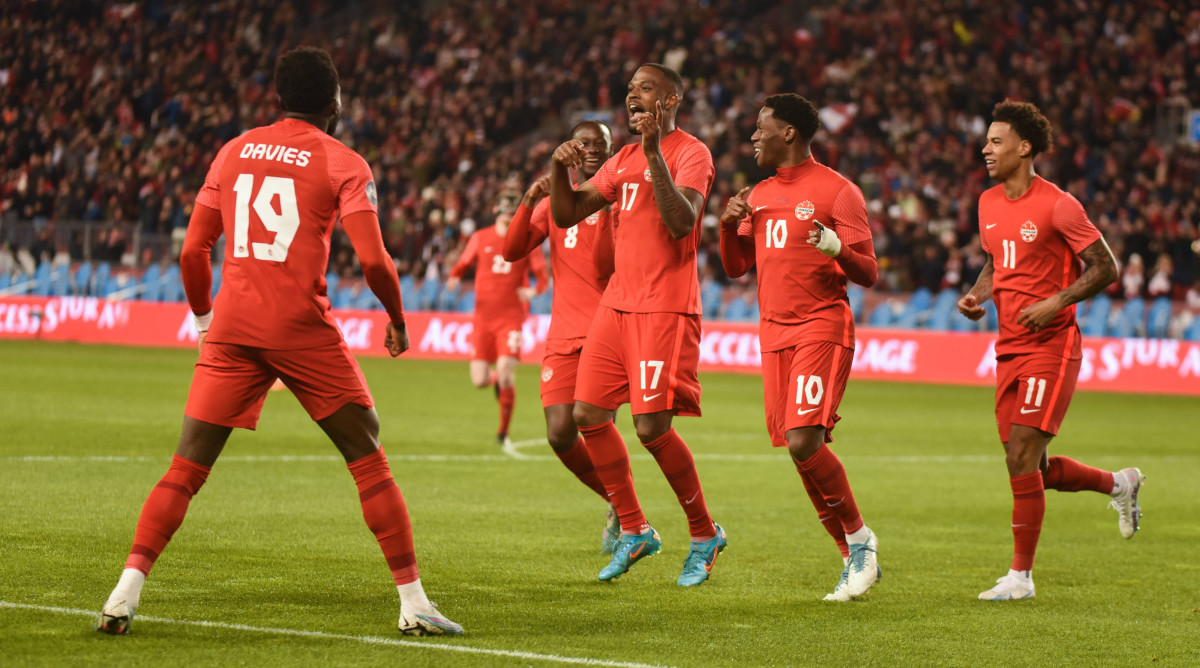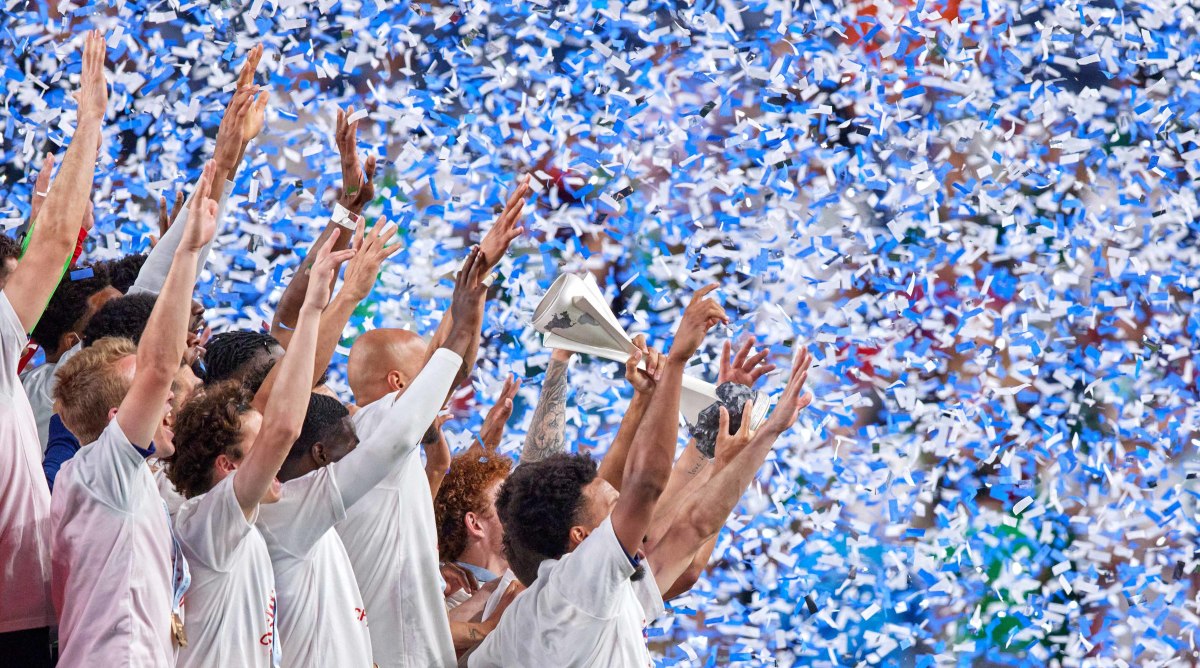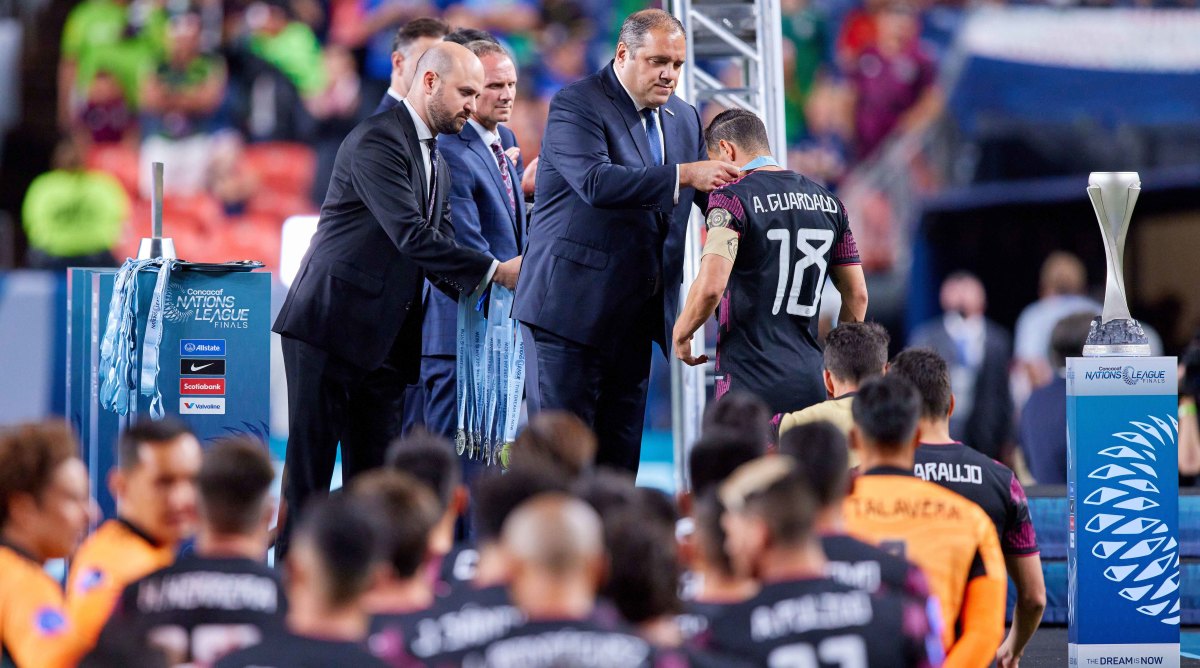Nations League, Gold Cup Summer Creates Dilemma for Crowning the Kings of Concacaf

The Canadian men are the Kings of Concacaf, with a capital K.
So they say.
Cyle Larin made some waves Monday when he told OneSoccer, “We’re the big boys,” following Canada’s easy Concacaf Nations League win over Honduras. But that was just one, happy, in-the-moment postgame answer to a question about moving on to play the region’s “big boys” this summer.
“Kings of Concacaf,” however, is right there in deliberate black and white at the bottom of every press release and statement sent out by Canada Soccer.
“Canada Soccer’s Men’s National Team are the reigning Kings of Concacaf,” it says, referencing the first-place finish in last year’s World Cup qualifying standings. That marked, the governing body claims, “the third time that Canada Soccer’s Men’s National Team won a Concacaf title.”
Canada’s coronation will be news to the U.S., which is the reigning Concacaf Gold Cup and Nations League champion and the only team from the region to escape the group stage at the Qatar World Cup. And it may also be of interest to Mexico, which still has lifted a lot more Concacaf trophies than anyone else.

First, for accuracy’s sake, there is no third title. The two-time Concacaf champion Canadians were excellent during qualifying, deservedly finished above the Americans and Mexicans and can brag about that all they’d like. But there was no trophy, no crown and no third anything. As for whether they’re the kings (small k) of Concacaf, that’s up for discussion. And the contention comes amid a bit of confusion that Concacaf itself—along with the pandemic—has helped create.
In June 2021, the best available U.S. players defeated the best available Mexican players in an epic and exhausting 120-minute final played before a raucous, sellout crowd in Denver. The Americans received their medals and raised a trophy. It felt like a championship. But it wasn’t. Less than two months later, a U.S. squad featuring just four men from foreign clubs—call it a B+ team—ground out a 1–0, extra-time win over El Tri in the Gold Cup final in Las Vegas. That was the regional championship—the bigger game by every definition. But it didn’t necessarily seem like it. It felt strange to send the A team to the B- competition and the B+ roster to the A competition. And the response in the U.S. to those results reflected that ambiguity.
Concacaf remains idiosyncratic. That’s part of its charm. But when it’s not clear which competition matters most—one could make a case for World Cup qualifying, even though there’s no trophy or title connected to it—it leaves room for competing claims. Concacaf created the Nations League to provide more frequent and structured competitive opportunities to the region’s mid- and lower-tier nations. And it wisely linked the Nations League to Gold Cup qualification, incentivizing the bigger countries to take it somewhat seriously.
The Nations League trophy and title are kind of superfluous. The point of the event—the reason of its creation and existence—is the group stage. But two nights of a packed NFL stadium (the semifinals and then the bronze and gold medal matches) is worth quite a lot to Concacaf, and it helps fund the rest of the competition. People would pay to see the U.S. play Mexico in a parking lot, so Concacaf may as well capitalize. The problem is that because of a scheduling crunch sparked by the pandemic, the region’s two national team events have cannibalized each other.
Nowhere else in the world would a national team consider sending a less-than-full-strength team to its confederation championship. After the World Cup, that’s the biggest trophy you can win. But the fact that the Nations League finals and Gold Cup are played back-to-back incentivizes teams with key players based in Europe—that’ll be the U.S. and perhaps Canada this June—to field a stronger squad in the shorter, less prestigious event (Mexico didn’t worry as much about resting players in 2021 and was runner-up in both competitions).

The first Nations League final was supposed to happen in March 2020 but was pushed to June ’21 by the pandemic. The ripple effect from that delay, plus the congestion created by the compressed World Cup qualifying competition, resulted in the second final four being scheduled for June ’23. This year’s Gold Cup then kicks off only six days after the Nations League concludes in Las Vegas (the draw is April 14).
Two years ago, USMNT coach Gregg Berhalter felt that asking his European players to finish up their club campaigns and then spend a month trying to win the Gold Cup—all when World Cup qualifying was set to kick off in September—was way too much. He took a bit of a gamble, and it worked. The U.S. won both the Nations League and Gold Cup trophies and then qualified for Qatar.
There is no World Cup qualifying this time around. The U.S., along with Canada and Mexico, will advance automatically as hosts. But it’s been a long season, with Qatar jammed into the middle. So U.S. Soccer and interim coach Anthony Hudson are leaning away from forcing players to contest the Gold Cup after just a couple of weeks of vacation, and before heading right back to their clubs for preseason (the Gold Cup final is July 16 in Los Angeles). Therefore, expect to see the big names in Las Vegas, where the U.S. and Mexico will meet in the semis (Canada and Panama are the other semifinalists). Then there will be a Gold Cup roster anchored by men from MLS, along with some younger European players who might be able to use the game time, experience or exposure (like the four on the 2021 Gold Cup team.)
As long as the Gold Cup remains somewhat devalued—either by the schedule or the frequency, or by a debate about whether the confederation champion really is its “King”—it makes sense for someone in Hudson’s position to prioritize the physical and mental health of his players. There are bigger tournaments coming up: the 2024 Copa América and then the World Cup.
It’ll be fascinating to see how Mexico and Canada handle this summer. Canada’s John Herdman certainly knows his team hasn’t won a regional trophy in 23 years and that doing so would be a significant step and symbol for a country on the rise. But a Gold Cup run would also represent a heavy workload for the likes of Larin, Alphonso Davies, Jonathan David and Tajon Buchanan, among others. Mexico manager Diego Cocca is new, but will be under immense pressure to win something and reassert El Tri’s claim to the summit of the Concacaf power ranking.

Meanwhile Hudson, who managed the U.S. to Nations League group stage wins over Grenada and El Salvador this month, already has a feel for his plan (that includes an April friendly against Mexico that’ll feature MLS and Liga MX players).
“We have a lot of programming coming up between now and the summer,” he said. “So for us to be able to really plan this out and have strong teams in all of these competitions, we have decided to select the team a certain way with these next few camps coming up.
“It’s a balancing act between when we get to the summer, the overseas players are going to need a break. And obviously with some of our domestic players, it’s a slight challenge for those guys because they potentially are going to be missing league matches with their clubs,” he continued. “We did this in 2021. It worked very well, where we obviously won both tournaments, and we more or less did it with two separate squads. So we were comfortable with that. We’ve done it before. And also it made sense in terms of trying to work with clubs and not overloading the players.”
This will be the last time for the foreseeable future that the summer crunch is this bad. The 2023–24 Nations League, which will qualify teams for next year’s Copa América, will conclude in March 2024 (the U.S. will get to skip the group stage and enjoy a bye to a new home-and-away quarterfinal scheduled for this November). The ’24–25 Nations League, which will send teams to the ’25 Gold Cup, also is scheduled to finish in March. The U.S. will have more leeway and incentive to select its strongest team that summer, in what are likely to be the last meaningful games before the ’26 World Cup. There probably won’t be a Nations League in ’25–26 as most of the region focuses on World Cup qualifying.
So the next few months should be as messy as it gets for a while. If Mexico, Canada or someone else wins this summer’s Gold Cup without a full-strength U.S. squad in the tournament, the identity of the regional champion will be clear. But depending on the Nations League result and how you prioritize or evaluate each competition, who’s really wearing the Concacaf crown will remain up for debate.
